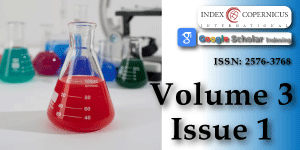Stoichiometric approach to redox back titrations in ethanol analyses
Main Article Content
Abstract
This article refers to calculations involved with determination of ethanol, analyzed according to redox back titration principle. A quantitative reasoning, based on logical sequence of statements, is presented for derivation of the formulas required to calculate the results of chemical analyses according to stoichiometric principles. The titrations are considered as two-step analytical procedures. This way, one can gain an insight into a classical redox titration and get a knowledge on the advantages of back titrations.
Article Details
Copyright (c) 2019 Anna M Michałowska-Kaczmarczyk, Tadeusz Michałowski

This work is licensed under a Creative Commons Attribution 4.0 International License.
Ferguson J. Estimation of Alcohol Content in Wine by Dichromate Oxidation followed by Redox Titration. Sirromet Wines Pty Ltd. Ref.: http://bit.ly/2WuM4PG
Bhosale Y, Mulani K, Rathod V. A Rapid and Precise Titration Method for Analysis of Ethanol: Comparison among Serum-Whole Blood Alcohol Concentration. Open Acc Blood Res Trans J. 2017; 1: 001-003. Ref.: http://bit.ly/2R193AR
Outreach. Determination of Ethanol Concentration in Aqueous Solutions. College of Science. University of Canterbury. Ref.: http://bit.ly/2K8PAxI
Redox Titration of Ethanol in Wine and Beer. Ref.: http://bit.ly/2K6qC1R
AP Chemistry. Determination of the Alcohol Content of Root Beer Lab. Ref.: http://bit.ly/2R1bOCd
Determination of Ethanol Concentration in Aqueous Solutions, College of Science, University of Canterbury. Ref.: http://bit.ly/2K8PAxI
Jain NC, Cravey RH. Analysis of alcohol. I. A review of chemical and infrared methods. J Chromatogr Sci. 1972; 10: 257-262. Ref.: http://bit.ly/2WWsRLb
Thompson T. Determining Blood/Alcohol Concentration: Two Methods of Analysis, Montana Law Review. 1985; 46: 365-379. Ref.: http://bit.ly/2KbzfIu
Ruz J, Fernandez A, De Castro MDL, Valcarcel M. Determination of ethanol in human fluids — I. Determination of ethanol in blood. J Pharmace Bio Analysis. 1986; 4: 545-558. Ref.: http://bit.ly/31j8APb
Wang ML, Su NW, Choong YM, Lee MH. A rapid method for determination of ethanol in alcoholic beverages using capillary gas chromatography. Journal of Food and Drug Analysis. 2003; 11: 133-140. Ref.: http://bit.ly/2WvQIlw
Miah R, Siddiqa A, Tuli JF, Barman NK, Dey SK, et al. Inexpensive Procedure for Measurement of Ethanol: Application to Bioethanol Production Process. Advances in Microbiology. 2007; 7: 743-748. Ref.: http://bit.ly/2ZjtSKD
Archer M, de Vos J, Visser MS. The preparation, assay and certification of aqueous ethanol reference solutions. Accreditation and Quality Assurance. 2007; 12: 188-193. Ref.: http://bit.ly/2IySet7
Michałowska-Kaczmarczyk AM, Spórna-Kucab A, Michałowski T. Generalized Electron Balance (GEB) as the Law of Nature in Electrolytic Redox Systems3 in: Redox: Principles and Advanced Applications. Ali Khalid MA (Ed.) InTech. 2017; Chap 2: 9-55. Ref.: http://bit.ly/2MCnX28
Michałowska-Kaczmarczyk AM, Spórna-Kucab A, Michałowski T0 Principles of Titrimetric Analyses According to Generalized Approach to Electrolytic Systems (GATES), in: Advances in Titration Techniques, Vu Dang Hoang (Ed.) InTech. 2017; Chap. 5: 133-171. Ref.: http://bit.ly/2X045d4
Michałowska-Kaczmarczyk AM, Spórna-Kucab A, Michałowski T. A Distinguishing Feature of the Balance 2∙f(O) – f(H) in Electrolytic Systems. The Reference to Titrimetric Methods of Analysis, in: Advances in Titration Techniques. Vu Dang Hoang (Ed.) InTech. 2017; Chap 6: 173-207. Ref.: http://bit.ly/2K8R8b0
Michałowska-Kaczmarczyk AM, Spórna-Kucab A, Michałowski T. Solubility products and solubility concepts, in: Descriptive Inorganic Chemistry. Researches of Metal Compounds. Akitsu T. (Ed.) InTech. 2017; Chap 5: 93-134. Ref.: http://bit.ly/2Wo6c6c
Wilkinson L. Optimum conditions of the acid dichromate method for determining ethanol in body fluids. Analyst. 1985;83: 390-401. Ref.: https://rsc.li/2FcXouj
OIV – Organisation Internationale de la Vigne et du Vin. Compendium of Methods of Analysis of Wine Vinegars. Resolution OENO 56-2000 V Wine Vinegards – Determination of the residual alcohol content. Ref.: http://bit.ly/2F2yAov
Association of Official Analytical Chemists (AOAC). Official Methods of Analysis. 16th ed.; AOAC: Gaithersburg, MD. 1997; 28.1-28.3.
Sáez Plaza P, Martín J, Asuero AG. Dichromate oxidation of ethanol and phenol bromination: a tale of two reactions, Anales de la Real Academia Nacional de Farmacia. 2017; 83: 313-320. Ref.: http://bit.ly/2Xxy4WO

